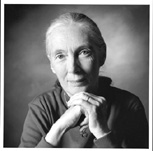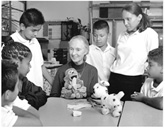Resources for Teachers and Students
Prepare: The Jane Goodall Institute of Wildlife
Research, Education and Conservation was initially set up
to support field research on wild chimpanzees. It has evolved
into an organization that promotes "compassionate action
to improve the environment for all living things."
Goodall's biography
and Curriculum
Vitae can be found on her website. Be certain to
check them out as they are quite impressive.
 Read:
Jane Goodall's Architects
of Peace essay is excerpted from an article she wrote
for Orion Magazine, titled " Four Rays of Hope."
In it she explores her reasons for hope even in a world
devastated by war and environmental degradation.
Read:
Jane Goodall's Architects
of Peace essay is excerpted from an article she wrote
for Orion Magazine, titled " Four Rays of Hope."
In it she explores her reasons for hope even in a world
devastated by war and environmental degradation.
Explore: The Goodall Institute maintains a "study
corner" to assist students who are writing
research papers related to her work. The study corner includes
links, a reading list, and a great deal of information about
chimpanzees.
Write: In 2002, UN Secretary-General Kofi Annan
proclaimed Jane Goodall a "Messenger of Peace."
She was the first scientist ever to be awarded this distinction.
Some people may wonder how the work of an ethnologist can
lead the world toward peace, since Goodall's major scientific
achievement has been to blur the line between humans, as
a species, and the animal kingdom in general. Compose a
five-page research paper that explores the question of whether
Goodall's approach to science can actually be considered
an avenue of peace. If it is, what does this imply about
how we define peace?
 Extend:
Through the Goodall Institute, it's actually possible to
become a "Chimpanzee
Guardian," adopting a chimp in the wild and
supporting the work of the institute's sanctuary program,
where more than 200 chimpanzees are now under protection.
Extend:
Through the Goodall Institute, it's actually possible to
become a "Chimpanzee
Guardian," adopting a chimp in the wild and
supporting the work of the institute's sanctuary program,
where more than 200 chimpanzees are now under protection.
Additional Resource: A video interview with Jane
Goodall, titled "Harbingers
of Hope," can be viewed online. The interview,
viewed in two parts, lasts fifteen minutes.
Biography of Jane
Goodall